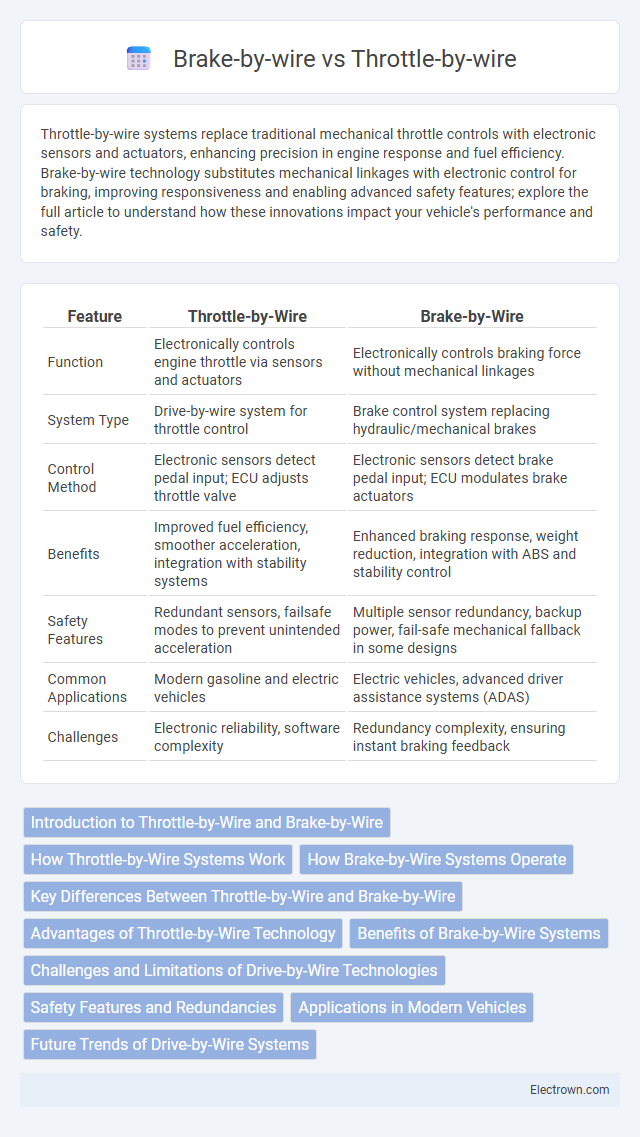Throttle-by-wire systems replace traditional mechanical throttle controls with electronic sensors and actuators, enhancing precision in engine response and fuel efficiency. Brake-by-wire technology substitutes mechanical linkages with electronic control for braking, improving responsiveness and enabling advanced safety features; explore the full article to understand how these innovations impact your vehicle's performance and safety.
Table of Comparison
| Feature | Throttle-by-Wire | Brake-by-Wire |
|---|---|---|
| Function | Electronically controls engine throttle via sensors and actuators | Electronically controls braking force without mechanical linkages |
| System Type | Drive-by-wire system for throttle control | Brake control system replacing hydraulic/mechanical brakes |
| Control Method | Electronic sensors detect pedal input; ECU adjusts throttle valve | Electronic sensors detect brake pedal input; ECU modulates brake actuators |
| Benefits | Improved fuel efficiency, smoother acceleration, integration with stability systems | Enhanced braking response, weight reduction, integration with ABS and stability control |
| Safety Features | Redundant sensors, failsafe modes to prevent unintended acceleration | Multiple sensor redundancy, backup power, fail-safe mechanical fallback in some designs |
| Common Applications | Modern gasoline and electric vehicles | Electric vehicles, advanced driver assistance systems (ADAS) |
| Challenges | Electronic reliability, software complexity | Redundancy complexity, ensuring instant braking feedback |
Introduction to Throttle-by-Wire and Brake-by-Wire
Throttle-by-wire technology replaces traditional mechanical throttle control with electronic signals, allowing precise and responsive engine power management. Brake-by-wire systems eliminate hydraulic linkages, using electronic sensors and actuators to control braking force, enhancing safety and responsiveness. Your vehicle benefits from improved efficiency and smoother control through these advanced automotive innovations.
How Throttle-by-Wire Systems Work
Throttle-by-wire systems use electronic sensors to detect your accelerator pedal position and send signals to the engine control unit (ECU), which precisely regulates the throttle valve opening. This eliminates mechanical linkage, allowing faster response and better fuel efficiency through adaptive adjustments based on driving conditions. The system integrates with traction and stability controls to optimize overall vehicle performance and safety.
How Brake-by-Wire Systems Operate
Brake-by-wire systems operate by replacing traditional hydraulic lines with electronic controls, using sensors to detect driver brake inputs and actuators to apply braking force precisely. These systems enhance responsiveness and allow integration with advanced safety features like anti-lock braking systems (ABS) and electronic stability control (ESC). The elimination of mechanical linkages improves vehicle weight distribution and offers better adaptability to autonomous driving technologies.
Key Differences Between Throttle-by-Wire and Brake-by-Wire
Throttle-by-wire systems electronically control engine throttle based on sensor input, replacing traditional mechanical linkages to enhance fuel efficiency and response time. Brake-by-wire systems use electronic controls to activate braking mechanisms, eliminating hydraulic components and improving precision and safety features such as anti-lock braking systems. Your choice between these technologies influences vehicle control dynamics, maintenance requirements, and system integration complexity.
Advantages of Throttle-by-Wire Technology
Throttle-by-wire technology offers precise and rapid throttle response, improving engine efficiency and vehicle performance by electronically controlling throttle valves without mechanical linkages. It enhances fuel economy and reduces emissions through better integration with engine management systems and adaptive driver inputs. The system also enables advanced safety features like traction control and cruise control, contributing to overall driving comfort and vehicle safety.
Benefits of Brake-by-Wire Systems
Brake-by-wire systems enhance vehicle safety by providing faster and more precise brake response compared to traditional hydraulic brakes, reducing stopping distances and improving control. These systems enable advanced driver-assistance features such as electronic stability control and adaptive braking, contributing to overall accident prevention. Integration with regenerative braking in electric vehicles increases energy efficiency while minimizing brake wear and maintenance needs.
Challenges and Limitations of Drive-by-Wire Technologies
Drive-by-wire technologies such as throttle-by-wire and brake-by-wire face challenges including system reliability, latency, and cybersecurity vulnerabilities that can affect vehicle safety and performance. Ensuring fail-safe redundancy and real-time response under varying driving conditions remains a significant limitation in widespread adoption. Integration complexity with existing automotive electronic architectures and regulatory compliance also impacts development and implementation costs.
Safety Features and Redundancies
Throttle-by-wire and brake-by-wire systems enhance vehicle safety by eliminating mechanical linkages and providing precise electronic control, reducing lag and improving responsiveness. Both systems incorporate multiple redundancies such as backup power supplies, dual sensors, and fail-safe modes to ensure continuous operation even in case of component failure. Your vehicle's safety relies on these electronic controls' ability to detect faults and seamlessly switch to backup mechanisms, preventing sudden loss of throttle or braking capacity.
Applications in Modern Vehicles
Throttle-by-wire systems in modern vehicles provide precise engine control by electronically managing throttle position, enhancing fuel efficiency and responsiveness. Brake-by-wire technology replaces traditional hydraulic braking with electronic controls, offering improved safety features such as adaptive braking and integration with advanced driver-assistance systems. Your vehicle benefits from these innovations through smoother acceleration and more reliable braking performance in diverse driving conditions.
Future Trends of Drive-by-Wire Systems
Future trends in drive-by-wire systems emphasize enhanced integration and autonomy, with throttle-by-wire and brake-by-wire technologies advancing toward seamless communication through centralized electronic control units (ECUs). Development efforts prioritize improved safety features, such as fail-safe mechanisms and adaptive response algorithms powered by machine learning, which optimize vehicle performance under varying conditions. Expansion of wireless connectivity and real-time data processing is expected to further accelerate the adoption of drive-by-wire systems in electric and autonomous vehicles, supporting precise and efficient control.
Throttle-by-wire vs Brake-by-wire Infographic

 electrown.com
electrown.com